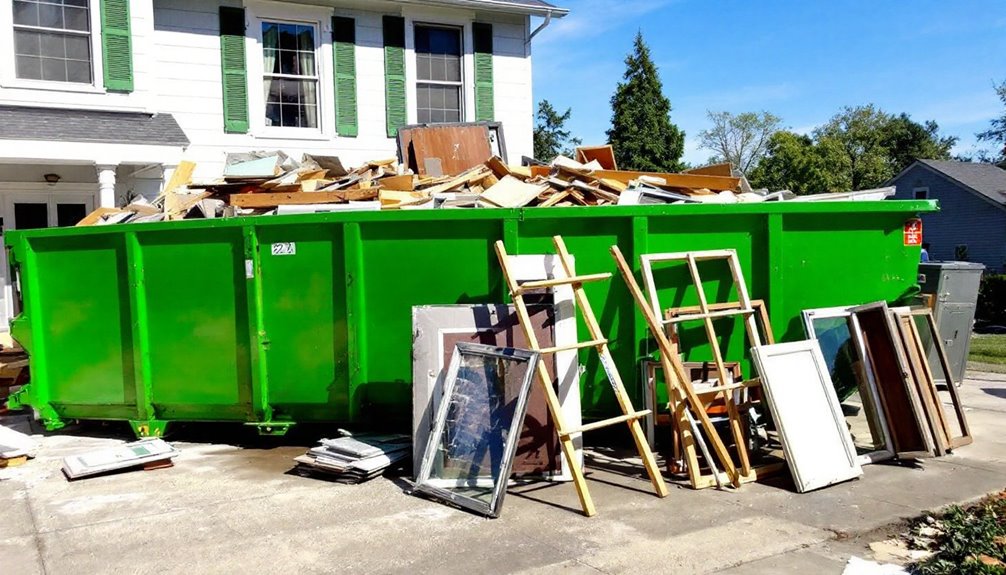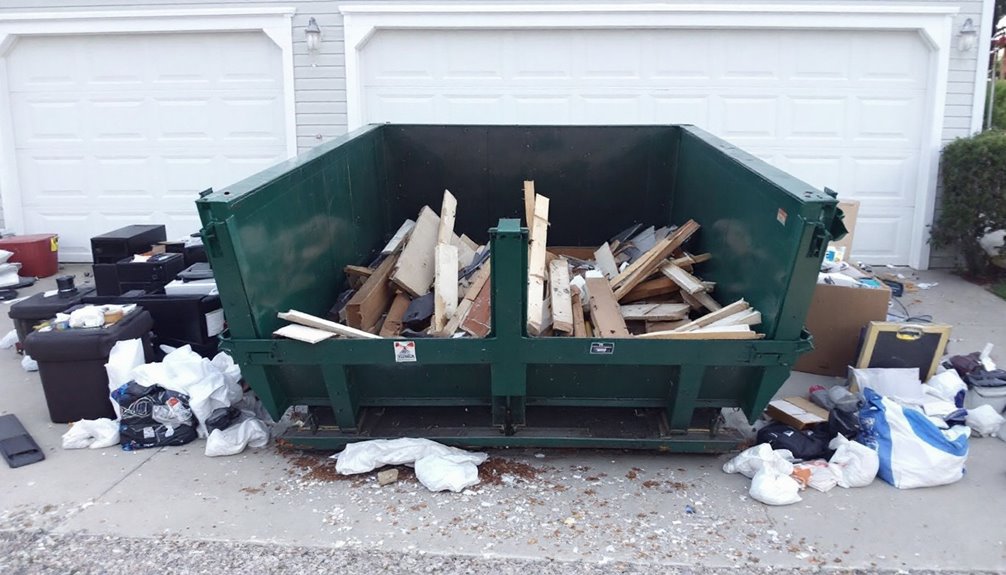You’ll need a 30-yard dumpster for major home renovations, whole-house remodels, or large commercial cleanouts. This sizeable container can handle about 190 trash bags or 9 pickup truck loads of debris, making it perfect for estate cleanouts, extensive roofing jobs, and multi-property cleanups. With dimensions of 22′ x 7.5′ x 6′, it’s ideal when you’re tackling big projects that generate significant waste. Let’s explore how to make the most of this substantial disposal solution.
Key Takeaways
- Major home renovations and additions require a 30-yard dumpster to handle large volumes of construction debris and materials.
- Estate cleanouts and large-scale property organization projects benefit from the 30-yard capacity of 170-190 trash bags.
- Commercial renovation projects involving heavy materials and demolition waste are ideal for 30-yard dumpster rentals.
- Large roofing projects requiring disposal of old shingles and roofing materials fit perfectly in a 30-yard container.
- Community cleanup events and multi-property waste removal projects need 30-yard dumpsters to minimize rental units and trips.
Understanding the 30-Yard Dumpster: Size and Capacity

What makes a 30-yard dumpster the right choice for your project? You’ll find these versatile containers typically measure 22 feet long, 7.5 feet wide, and 6 feet high, though dimensions can vary by manufacturer. What’s consistent is their impressive 30 cubic yards of waste capacity.
You’ll be pleased to know that your 30-yard dumpster can handle the equivalent of 170-190 33-gallon trash bags or about nine pickup truck loads. That’s plenty of space for your renovation debris, old furniture, or construction materials. With weight limits ranging from 2 to 5 tons, you’ve got substantial capacity for your disposal needs. These containers are ideal for major home renovations and new construction projects. Just remember to stay within these limits to avoid extra charges. Zap Dumpsters offers exceptional customer service and flexible rental periods to accommodate your project timeline. While you can’t dispose of hazardous materials or heavy items like concrete, you’ll find these dumpsters perfect for most large-scale cleanup projects.
Perfect Projects for a 30-Yard Dumpster Rental
Anyone tackling a major home improvement or cleanout project will find a 30-yard dumpster invaluable. When you’re planning significant renovations, demolitions, or large-scale cleanouts, you’ll need reliable waste management to keep your project running smoothly. A 30-yard container is perfect for both residential and commercial projects that generate substantial debris.
Home additions and whole-house remodels that involve removing walls and fixtures
Commercial renovations requiring the disposal of heavy materials like concrete and metal
Estate cleanouts and property organization projects
Major roofing jobs and exterior demolition work
Community cleanup initiatives and multi-property waste removal
You’ll benefit from fewer trips to the landfill, improved site safety, and the flexibility to complete your project on your timeline. Plus, you’ll have peace of mind knowing you’re meeting local disposal regulations while managing waste efficiently.
What You Can and Cannot Throw Away

Before tossing items into your 30-yard dumpster, you’ll need to understand the clear distinctions between acceptable and prohibited materials. You can safely dispose of most household items, including old furniture, construction debris, and yard waste. Common acceptable materials include couches, tables, drywall, lumber, branches, and general household clutter.
However, you’ll need to make alternative arrangements for hazardous materials, electronic waste, and specialized items. Don’t place chemicals, batteries, paint, motor oil, or electronic devices in your dumpster. These items require special handling. Also avoid disposing of medical waste, tires, asbestos, and concrete. If you’re unsure about specific items, check with your rental provider – they’ll guide you through local regulations and help guarantee you’re disposing of materials properly and responsibly.
Cost-Saving Benefits of Choosing a 30-Yard Container
Understanding proper disposal methods is important, but so is maximizing your investment in a dumpster rental. When you choose a 30-yard container, you’ll benefit from significant cost savings through reduced trips to disposal facilities and lower labor costs. You’ll eliminate the need for multiple smaller dumpster rentals while keeping your workspace organized and efficient.
With prices ranging from $451 to $969, a 30-yard dumpster offers excellent value for large projects. Here’s how you’ll save:
- Fewer trips to landfills and recycling centers mean reduced fuel and labor expenses
- Single container rental versus multiple smaller dumpsters cuts overall costs
- Transparent pricing includes delivery, pickup, and disposal fees
- Increased efficiency allows workers to focus on core tasks
- Compliance with regulations helps avoid costly fines and delays
Expert Tips for Loading Your Dumpster Efficiently
Loading a 30-yard dumpster calls for smart planning and careful execution to maximize its capacity. Begin by creating a solid foundation with your heaviest items, placing bulky furniture, appliances, and construction debris at the bottom. This will guarantee stable weight distribution and safer transport.
Break down large items and organize them before loading to make the most of your space. You’ll want to fill the dumpster systematically from front to back, using the walk-in feature for precise placement of heavy materials. As you load, fill gaps with smaller items to prevent shifting and enhance stability.
Don’t forget to prioritize safety by wearing proper protective gear and keeping the load level with the container’s walls. Remember, you’re aiming for a well-organized, compact load that’ll make the most of your rental investment.
Frequently Asked Questions
How Far in Advance Should I Schedule a 30-yard Dumpster Rental?
You’ll want to schedule your 30-yard dumpster 2-3 weeks ahead, especially during spring and fall. If you’re in a busy urban area or planning a longer rental, book even earlier.
Can I Move the Dumpster After It’s Placed on My Property?
You shouldn’t move the dumpster after placement. It’s unsafe, could violate your rental agreement, and might result in extra fees. If you need it relocated, contact your rental provider.
What Happens if It Rains While I Have the Dumpster?
You’ll want to cover your dumpster with a tarp to prevent rain from soaking materials and adding weight. Rain-soaked debris can increase costs and create disposal issues through excess water weight.
Do I Need a Permit to Place the Dumpster on My Street?
You’ll need a permit if your dumpster will be on public streets or sidewalks. Check with your local public works department, as requirements vary by city and neighborhood.
How Long Can I Keep the 30-Yard Dumpster at My Location?
You’ll typically get 7-14 days with your 30-yard dumpster rental, but many companies are flexible. You can often extend your rental period for an additional daily fee if you need more time.
Conclusion
Now you’re equipped to make the right choice about renting a 30-yard dumpster for your next big project. Whether you’re tackling a major home renovation, clearing out an estate, or managing construction debris, remember to plan, follow loading guidelines, and stick to approved materials. By choosing the right size container and using it efficiently, you’ll save time and money while keeping your project on track.